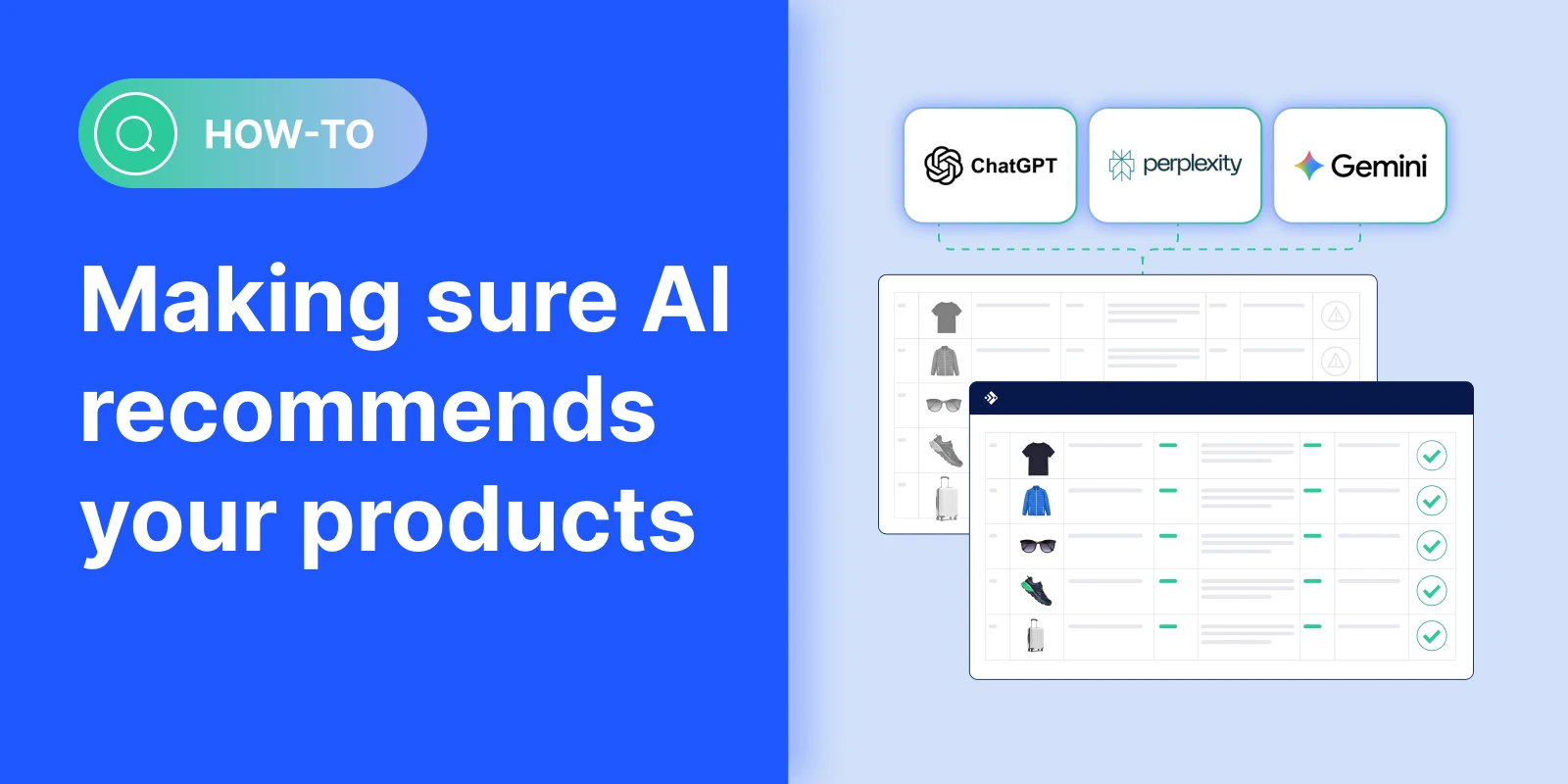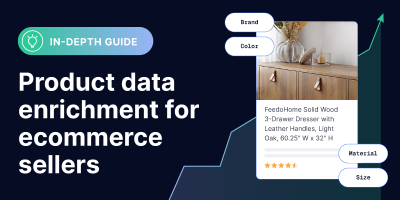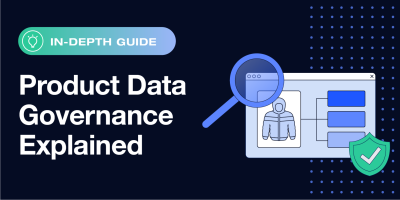From Google’s AI Mode and agentic checkout to AI-powered engines like Perplexity and ChatGPT, the next wave of ecommerce discovery is driven by intelligent systems that crawl, interpret, and recommend products based on structured data.
These AI systems are scanning your product listings and pages for clean, complete, and well-structured information. That means your product data is the key to showing up in AI-powered search, ads, and recommendations.
If your listings are vague, inconsistent, or missing key details, AI systems can’t confidently interpret or surface them. What used to result in a weaker user experience or reduced visibility now carries a much greater risk: your products may not be recommended at all. And that means lost traffic, lower conversions, and missed opportunities to connect with high-intent shoppers.
In this blog, we break down what AI product data enrichment is, why it matters, and how to automate and streamline the process using powerful enrichment tools that help retailers transform messy datasets into high-quality, ecommerce-ready product listings.
What is AI product data enrichment?
AI product data enrichment can be understood in two different ways:
- Using AI to enrich product data (e.g., generating product descriptions or categorizing listings)
- Enriching product data to make it more accessible and actionable for AI systems
While Feedonomics supports both approaches through advanced enrichment tools like FeedAi and can be used in conjunction with generative AI, this article focuses on the second definition: optimizing your product information so that AI systems, like search engines, recommendation engines, and shopping assistants, can better understand, evaluate, and surface your products.
It’s not about cramming more keywords into your titles or descriptions. Enrichment means transforming your raw product data into clean, contextual, and machine-readable content that aligns with the expectations of modern AI-powered platforms.
How to make sure AI finds and recommends your products
AI typically discovers your product data in three ways, and you have varying levels of control for each method:
- Web crawls to scrape your product data from your site (least control)
Passive scraping is the least reliable method of getting your data to appear in AI results—some AI platforms simply crawl your site and extract what they can. The problem? This approach is inconsistent and often out of your hands. If your site isn’t perfectly structured or if the AI misinterprets your content, your products could show up with missing details, or not at all, and you might not even realize it until it’s too late. Feedonomics prepares your product data to be crawled by creating well-structured and complete listings on third-party channels like Google Shopping, Amazon, and other marketplaces. This improves the quality of a passive crawl on those sites and helps AI understand your products. - Model Context Protocols, which allow AI to query your data directly (moderate control)
A step up from scraping is the use of Model Context Protocols (MCPs), currently being developed by platforms like Shopify and commercetools. These API-based frameworks allow AI tools to query product data directly, offering more structure than scraping but still giving merchants limited say in how their products are prioritized or contextualized in AI responses. They are valuable for providing AI platforms the blueprints for retrieving and interpreting your data from your site. - Syndication platforms like Feedonomics (most control)
For full control, brands are turning to feed management platforms like Feedonomics. Rather than solely relying on scraping or generic API access, Feedonomics enables businesses to curate and distribute structured, enriched product data directly to AI-powered platforms. From technical specs to lifestyle tags and FAQs, you choose how your products are represented—ensuring they appear accurately and persuasively wherever AI shopping tools are surfacing results. Ultimately, Feedonomics is investing in solutions for all three methods to ensure brands are structuring their data in an AI-friendly way, as well as optimizing listings for human shoppers at the same time.
Here are the essential elements your product listings and pages need to ensure they’re properly interpreted and ranked by AI engines:
#1 Fill in as many product attributes as possible
The more structured product information you provide, the easier it is for AI to understand what you’re selling and determine if it matches a shopper’s query. Comprehensive attributes in your product feeds enable AI used in search, social, and marketplaces to interpret, evaluate, and recommend your listings.
For example, an electronics seller might technically meet listing requirements on a marketplace by including only basic details like dimensions, weight, and color. But that minimal approach limits how AI can interpret the product. An enriched listing, by contrast, includes a fuller set of attributes, enabling AI to match it to more relevant searches and shopper intents across channels.
For example, a wireless earbud seller might include some of the following additional information on their listing:
- Material: ABS Plastic
- Battery Life: 30 hours
- Charging Port: USB-C
- Compatibility: Android & iOS devices
- Included Accessories: Charging cable, ear tips (S/M/L)
Adding these optional attributes is critical on your ecommerce website’s product pages as well. Many AI systems crawl your site directly to evaluate product information, and clearly defined specs (like dimensions, material, and compatibility) improve your visibility in AI-powered search, voice assistants, and SEO-driven discovery.
#2 Optimize your product titles and descriptions
Your product titles and descriptions play a critical role in how AI systems understand and rank your listings.
Strong titles and descriptions should be:
- Keyword-rich but not spammy
- Specific about key features and use cases
- Written in natural, readable language
- Aligned with SEO, channel, and AI engine expectations
The example below highlights how product titles impact both human readability and AI-driven discovery.
On the left, the title is vague and lacks meaningful detail—AI systems have little context to interpret or match it with shopper intent. On the right, the enriched version includes brand, material, and product dimensions—details that AI can confidently use to surface the listing in relevant search results.
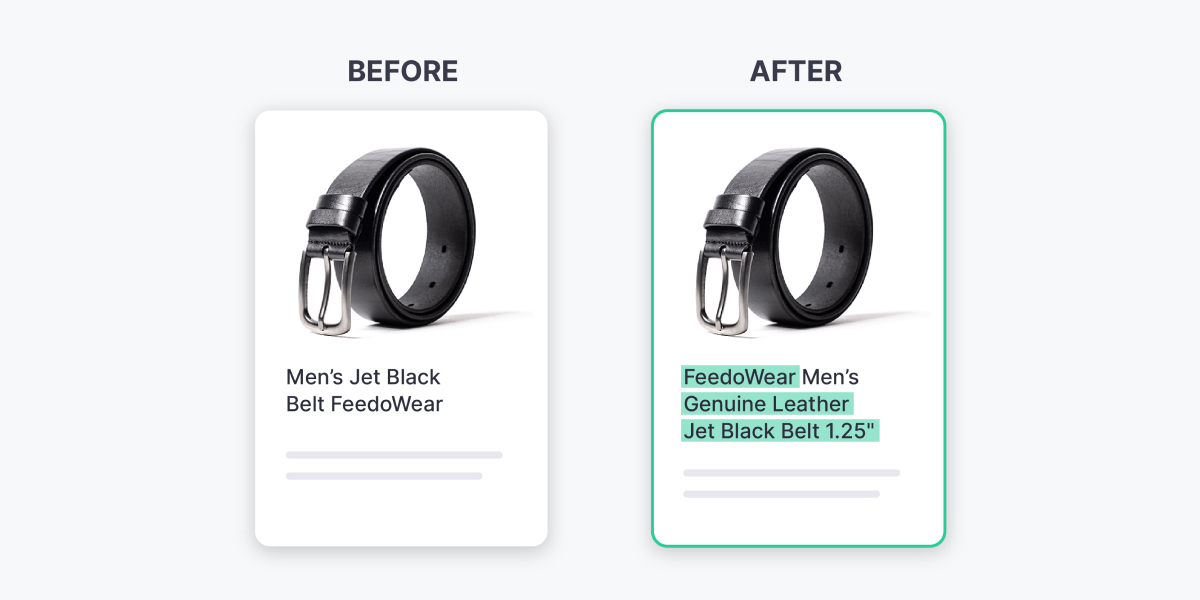
This next example illustrates how enriched product descriptions and bullet points can dramatically improve how both AI and customers interpret your listings.
On the left, the content is vague and lacks context, making it harder for AI systems to match the product with shopper queries. On the right, the enhanced version includes material details, use cases, and fit specifications—all in structured, easy-to-parse language.
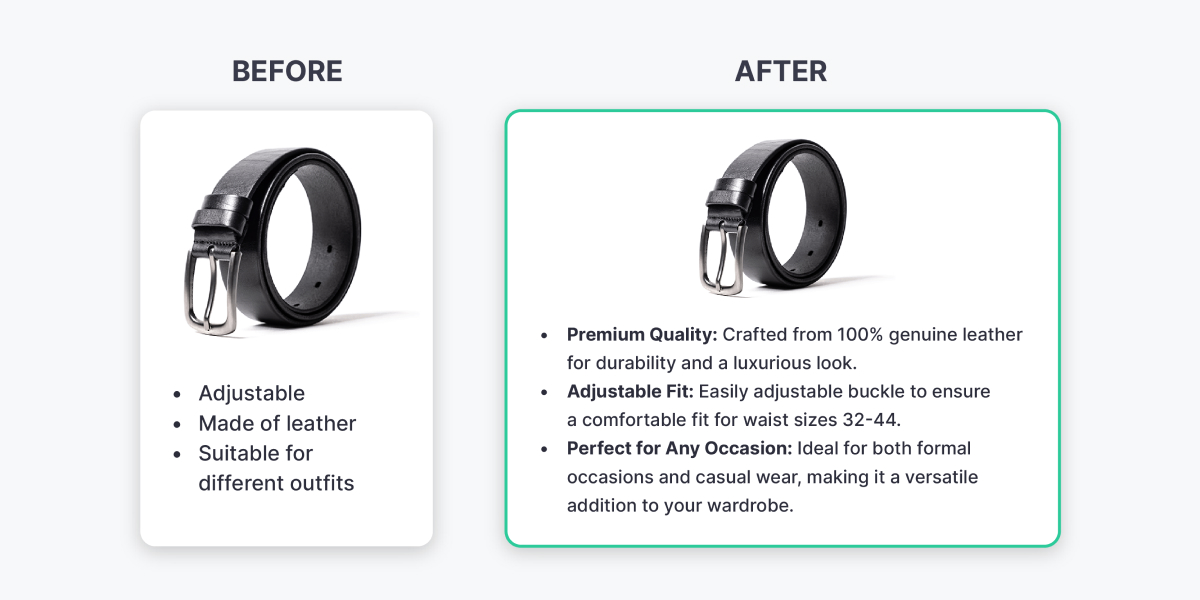
This enriched content appeals to shoppers, is machine-readable, and is packed with product information that AI systems use to evaluate and recommend listings.
Feedonomics enables sellers to generate or enhance titles and product descriptions at scale, helping retailers optimize their listings for AI systems without spending hours manually rewriting content.
#3 Categorize your products accurately and granularly
AI systems depend on accurate product categorization to understand what your product is, who it’s for, and where it fits in the broader product ecosystem. If your category is too broad—or worse, incorrect—AI engines may struggle to confidently recommend your product or match it to relevant shopper queries.
For example, labeling a dresser simply as “Furniture” provides very little context. But breaking it down into a more granular path—Furniture > Cabinets and Storage > Dressers—tells AI exactly what the item is and where it belongs.
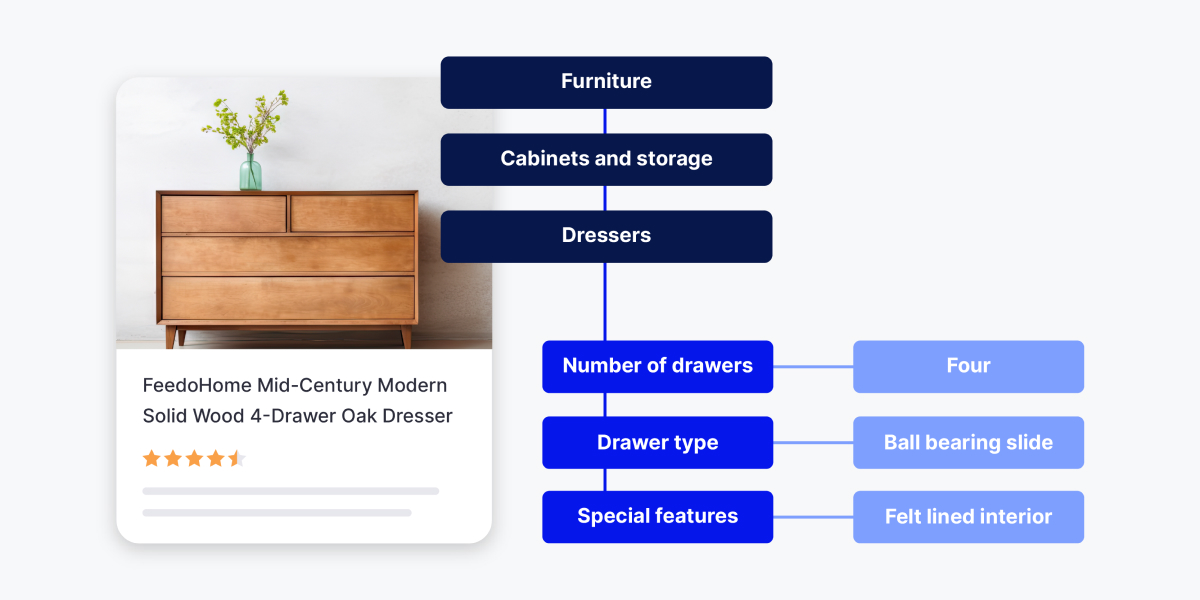
This level of granularity also unlocks category-specific attributes like number of drawers, drawer type, and special features (e.g., felt-lined interior). These added details help AI systems better evaluate and promote the product to the right audience.
Using platform-aligned taxonomies—like Google’s Product Taxonomy or Meta’s Commerce Catalog—ensures that your products appear where they’re supposed to, improving both discoverability and campaign performance across search, social, and marketplaces.
Feedonomics uses FeedAi, a machine-learning–powered categorization tool, to automatically map products to the most accurate categories based on title, description, and other attributes, saving time and improving categorization consistency.
#4 Use structured data fields
Even if you include the right product information, AI systems may not be able to understand or use it unless it’s properly structured. Attributes like material, size, and dimensions shouldn’t be buried in paragraphs of text or scattered inconsistently across listings—they need to live in clearly labeled fields that AI can recognize and act on.
This is where structured data comes in. But not all structured data is the same, so let’s clarify the two types that matter most for ecommerce.
Product feed structured data (for channels like Google Shopping, Meta, Amazon, etc.)
Structured data in your product feed is typically submitted to platforms like Google, Facebook, Instagram, or Amazon. This data is organized into a clean format (CSV, XML, TSV, or JSON) that includes fields (also known as attributes) like title, description, price, availability, brand, and more.
Regardless of the file format, each feed contains product attributes (represented by column headers in the spreadsheet below) and values (represented by the rows in the spreadsheet).
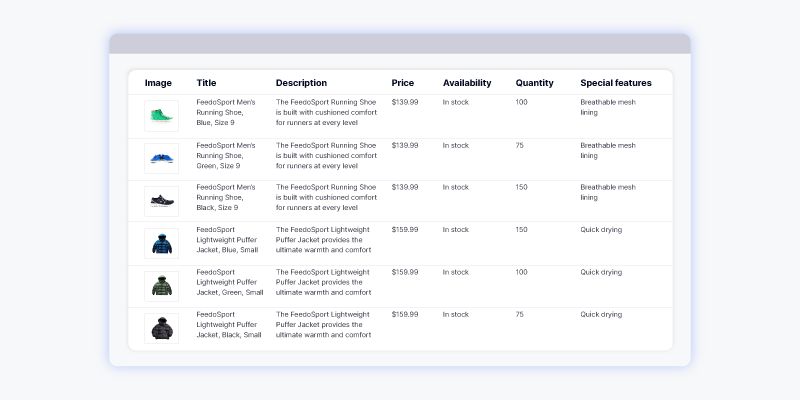
These fields are mapped to each channel’s unique requirements and are used to power:
- Ad campaigns and marketplace listings
- Product targeting in AI-powered recommendation engines
- Real-time pricing and inventory updates across channels
This kind of structured data is designed to be highly scalable and dynamic, making it ideal for multi-channel ecommerce and campaign automation.
To go one level deeper, the way you input those product attributes (especially when it comes to more lengthy fields like descriptions) should also be considered when it comes to overall structure.
On-site structured data (for Google Search, SEO, and AI crawlers)
In contrast, structured data on your website uses Schema.org markup—usually in JSON-LD format—to help Google Search (and its new AI mode), Google Images, and other AI systems understand the content of your product pages.
Structured data does not display on the page visually, but it’s embedded in the code and read by machines to enhance indexing and product visibility.
On-page structured data powers:
- Rich results like product ratings, availability, and pricing
- Google’s Shopping knowledge panels and image-based product discovery
- Indexing by AI systems like Perplexity, ChatGPT, and other generative AI crawlers
Key markup types include:
Product: name, brand, material, GTIN, descriptionOffer: price, availability, shipping detailsReview/AggregateRatingMerchantReturnPolicyandShippingDeliveryTime
The more complete and structured your on-page markup is, the more likely your product will appear in AI-enhanced search experiences.
Below is an example of minimal product structured data using JSON-LD markup, following Google’s best practices for merchant listings and rich results. It includes the essential properties—such as product name, description, brand, SKU, pricing, and availability—that help search engines and AI systems understand and display your product accurately across search and shopping experiences.
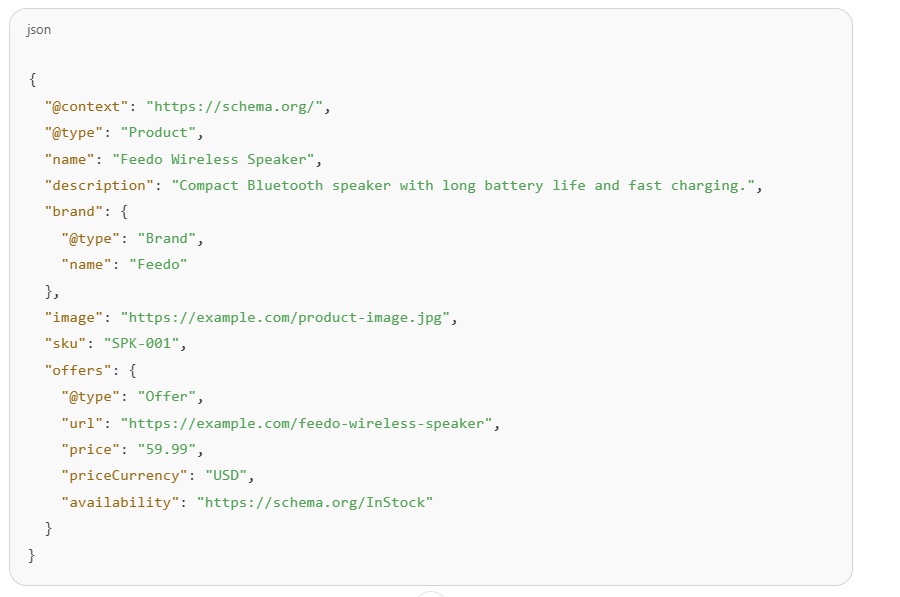
Feedonomics helps automate this by transforming unstructured product content into clean, structured data fields using customizable rules and enrichment tools, making your listings more accessible to AI across all sales channels.
#5 Maintain clean and standardized formatting
While structured fields tell AI where to find your data, a clean, standardized format ensures AI can interpret that data correctly.
A lack of formatting consistency can confuse AI engines, resulting in missed matches, inaccurate product categorization, or dropped listings altogether. Just as importantly, inconsistent formatting adds friction with shoppers, merchandisers, and even your own team, who’ll have a harder time spotting listing issues. This is especially critical for global feeds and multi-variant products.
To maintain high data quality, standardize the following across your catalog:
- Units of measurement (e.g., use “in” or “inches” consistently—not both)
- Attribute casing and punctuation (e.g., “Fast Charging” vs. “fast charging”)
- Product titles, dimensions, and pricing formats
- Avoidance of typos, irregular characters, or mixed naming conventions
Feedonomics helps streamline formatting across your entire product catalog by automating data transformation, manual cleanup, and reducing errors with built-in data governance features.
#6 Keep your data synchronized and updated
When AI crawls your product pages, or built-in marketplace AIs like Amazon’s Rufus read your product listings, it’s important that your product information is up-to-date.
Not only does outdated product data hurt the customer experience and your reputation, but it also reduces the likelihood of AI recommending your products again if users have a bad experience on your site or leave negative reviews.
If you’re unable to keep your product data consistently updated, you’ll create operational headaches for yourself when it comes to fulfillment and refunding payments.
As you continue to optimize your data for better discovery and conversions, you want to make sure those changes are distributed across all the touchpoints where customers find your products. With Feedonomics, you can keep your product data like inventory, pricing, titles, and descriptions synchronized across marketplaces, ad channels, and your ecommerce platform.
#7 Incorporate ratings, reviews, and social proof
Imagine asking your AI platform, “What do customers think about this product?”
Some AI systems will weigh social signals like ratings and reviews to gauge trustworthiness, popularity, and buyer sentiment. These signals help AI engines decide which products to prioritize, especially when multiple listings offer similar features.
When this type of content is missing, your listing may look incomplete or unproven to both algorithms and shoppers. But when social proof is added, such as an average star rating, review count, highlighted feedback, or a “Top Seller” badge, it gives AI and buyers a stronger reason to engage.
Prepare your data today to win across channels tomorrow
AI is only as good as the data it’s fed. If your product listings are incomplete, inconsistent, or poorly structured, no amount of smart algorithms can save them from being overlooked.
That’s why product data enrichment is essential. It’s the difference between being surfaced by cutting-edge AI engines or slipping into digital obscurity.
With Feedonomics, you don’t have to overhaul your tech stack or build complex AI integrations from scratch. We make it scalable, seamless, and centralized—so your product data is always optimized, always current, and always ready, no matter where your customers shop.
Invest in better data today to lead in ecommerce tomorrow.
AI product data enrichment FAQs
What is enriched data in the context of ecommerce products?
Enriched data refers to product listings that have been enhanced with complete, accurate, and structured information—such as specifications, attributes, images, and social proof—that improve visibility and performance across channels. This enrichment process makes listings more useful to both AI systems and shoppers by providing the context needed for confident matching and recommendation.
Why is product data enrichment important for artificial intelligence in ecommerce?
Artificial intelligence relies on structured, clean, and well-labeled data to accurately interpret and recommend ecommerce products. Without enriched data, AI tools can misinterpret or overlook listings entirely. Enrichment ensures your products are machine-readable, discoverable, and optimized for today’s data-driven shopping journeys.
How does data cleansing fit into product data enrichment?
Data cleansing is a foundational step in the enrichment process. It involves identifying and correcting issues like typos, inconsistent units, or formatting errors before enhancement begins. Clean data improves the accuracy of AI interpretation and ensures that downstream systems, like ad channels or recommendation engines, function properly.
How does product data enrichment improve conversion rates and customer experience?
Enriched product data makes listings more complete, searchable, and relevant to what customers are actually looking for. By improving the clarity and quality of attributes like size, material, compatibility, and images, shoppers can make faster and more confident decisions—leading to better conversion rates. It also reduces friction in the buying journey, improving the overall customer experience across your ecommerce site, ads, and marketplaces.
Why use a feed management platform for product data enrichment?
A feed management platform gives you centralized control over your product data, allowing you to clean, enrich, and distribute it efficiently across multiple channels. Instead of managing product listings separately for marketplaces, social media apps, and ad platforms, you can build automated workflows that transform raw product data into optimized, AI-ready listings.
Platforms like Feedonomics pull from various data sources—including your ecommerce platform, ERP, and PIM—and apply rules to enhance attributes, map categories, standardize formatting, and ensure consistency across every touchpoint. This reduces time-consuming manual tasks and improves data management across teams.
By using a feed management platform as your enrichment engine, you can support smarter marketing efforts, improve product discoverability, and enable better decision-making across your ecommerce tech stack. And with Feedonomics’ full-service team managing your product feeds, you don’t have to do it alone.

Muhammed is a content marketing specialist creating informative content to help ecommerce professionals solve industry challenges and stay ahead of the curve.
